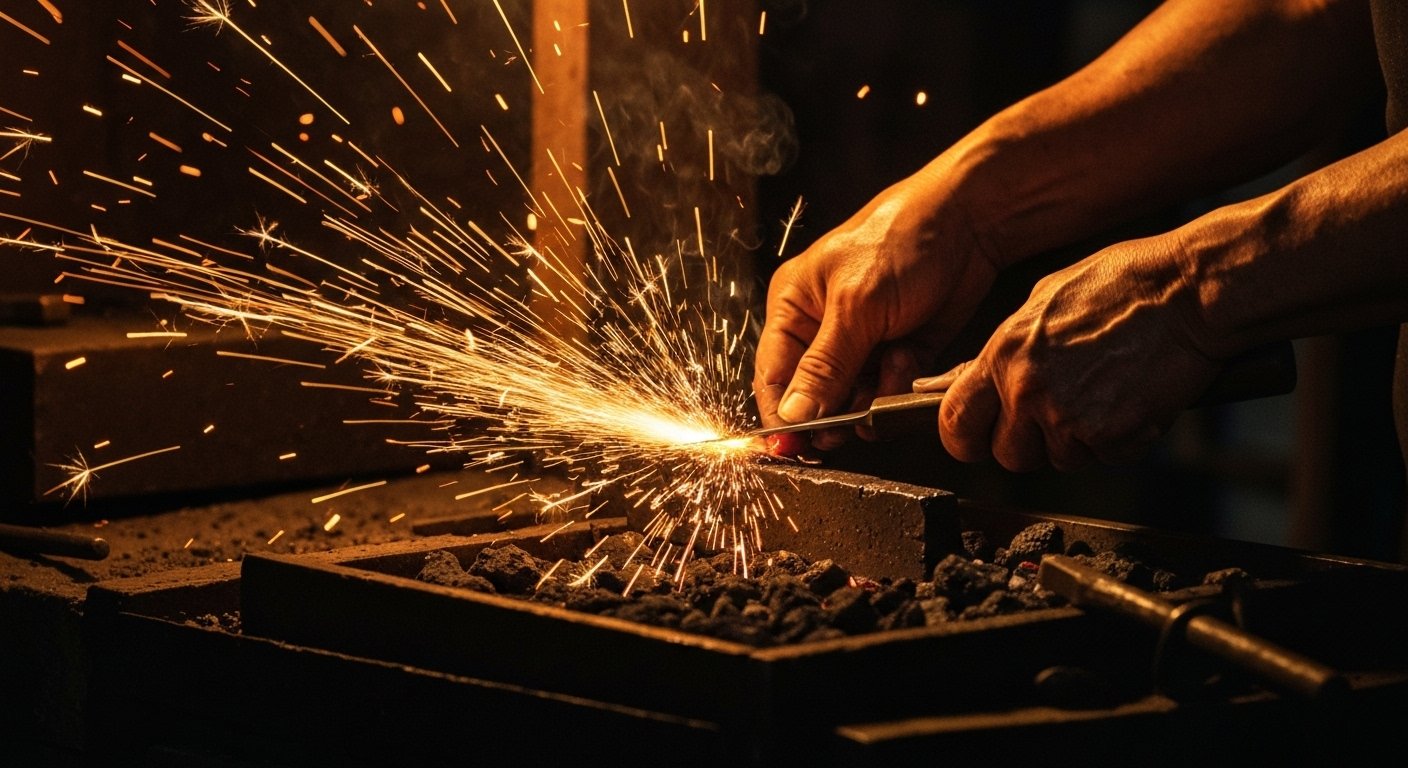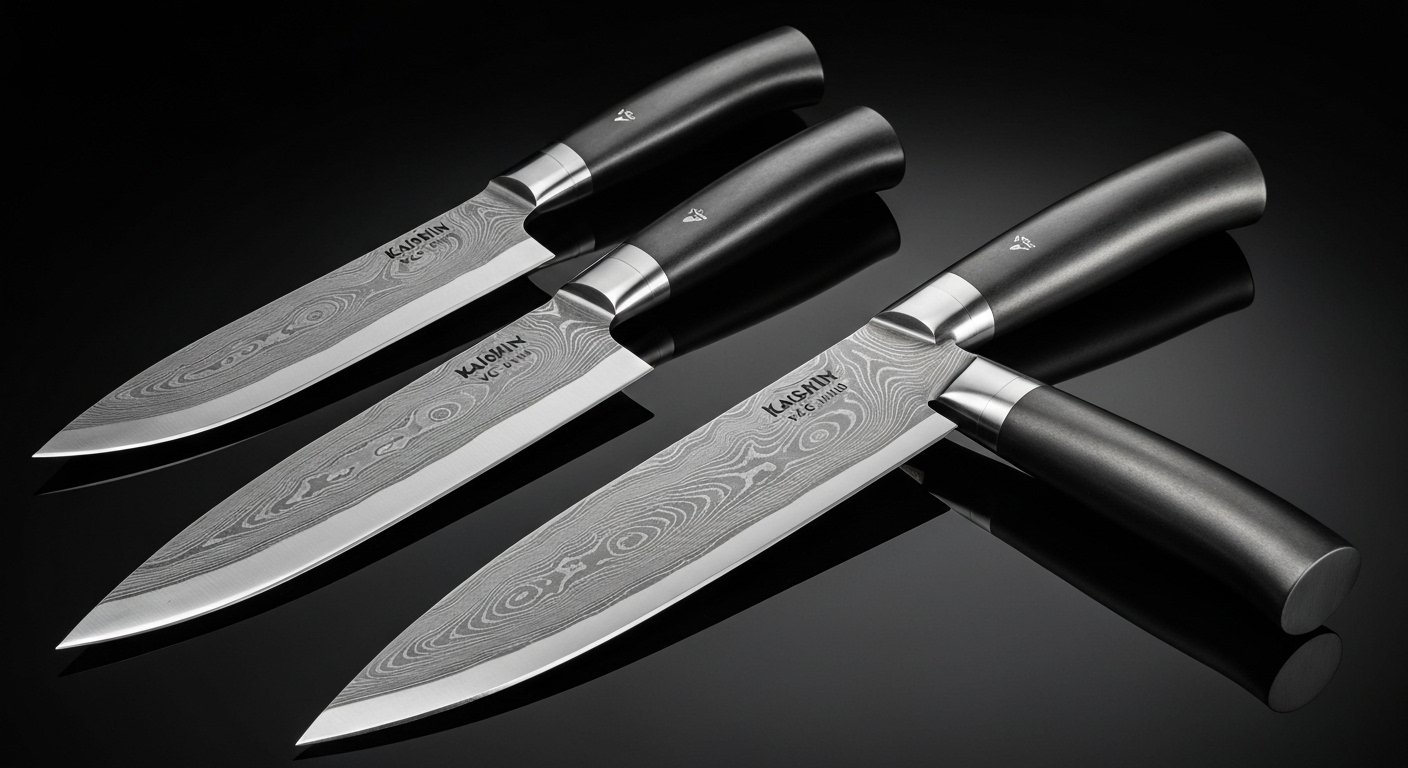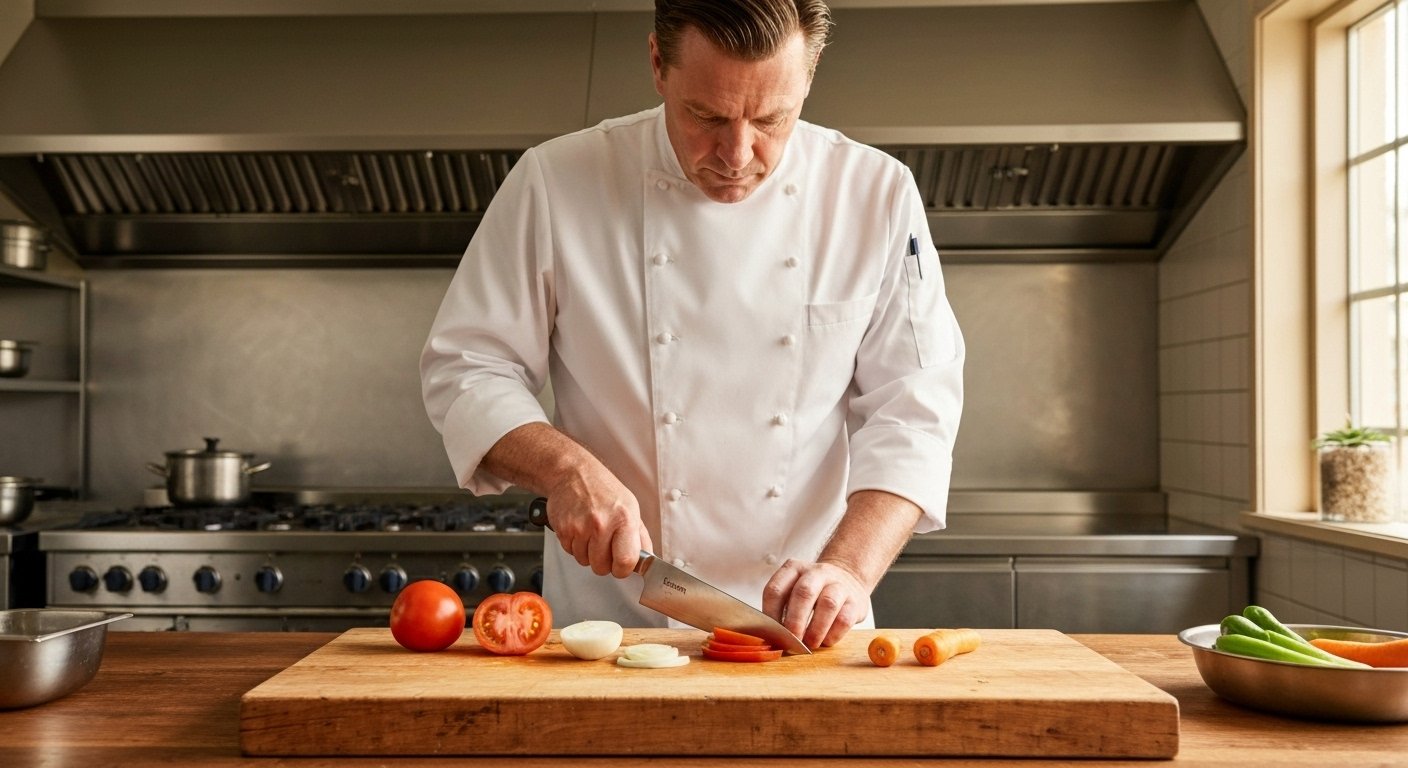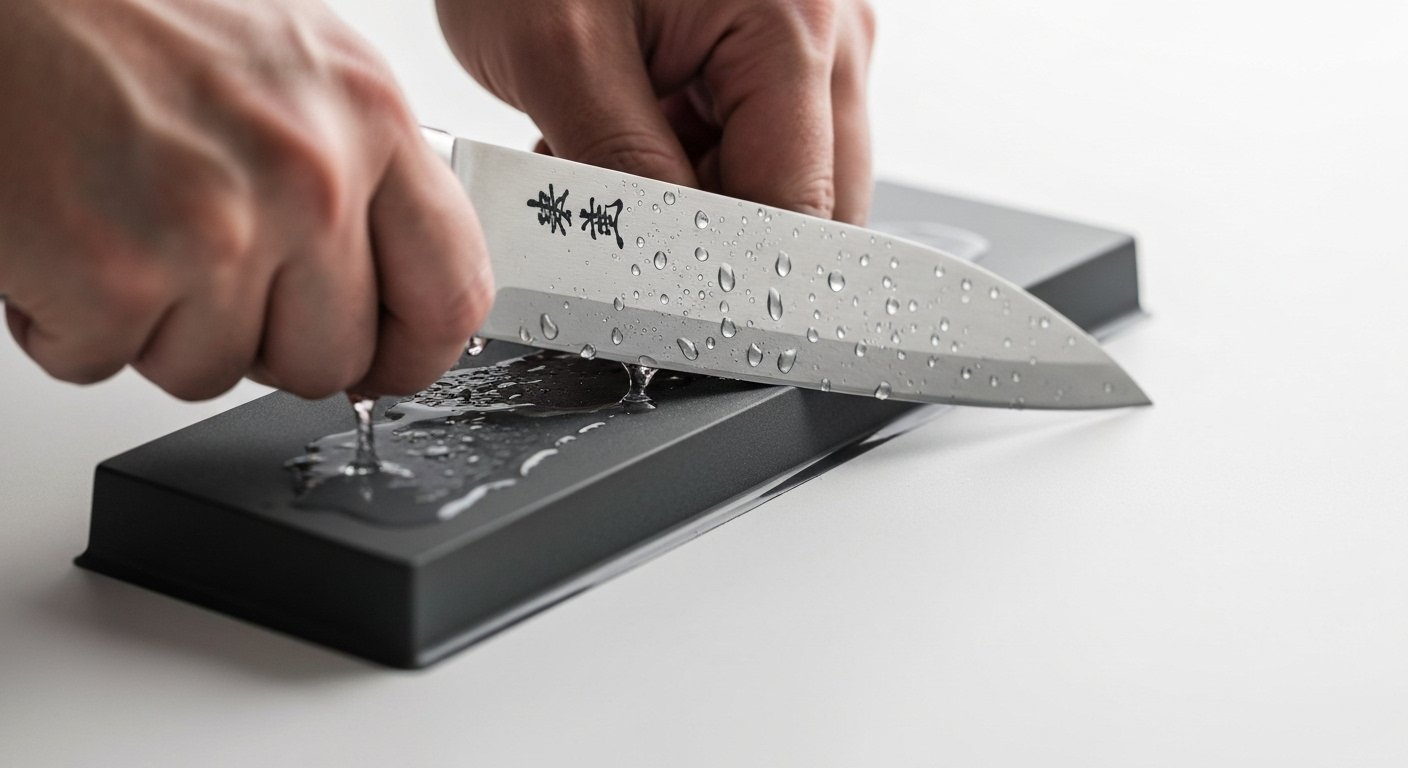rogerdavid1011@gmail.com
July 19, 2025
The culinary world reveres precision, artistry, and heritage, qualities epitomized by the finest Japanese cutlery. Among these esteemed blades, kaishin knives have carved out a distinctive niche, representing a pinnacle of professional craftsmanship and unwavering dedication to the art of knifemaking. This comprehensive guide delves into what makes kaishin knives a preferred choice for discerning chefs and enthusiasts alike, exploring their unique attributes and the meticulous processes that bring them to life.
The term “Kaishin” itself evokes a sense of renewal, innovation, and heart, reflecting the philosophy behind these exceptional tools. It’s not merely about sharpness; it’s about the complete culinary experience they enable. Each kaishin knife is a testament to centuries of Japanese blade-smithing tradition, fused with modern metallurgical advancements.
The true distinction of kaishin knives lies in their holistic design approach. This encompasses everything from the selection of premium steels to the ergonomic shaping of the handle, ensuring perfect balance and comfort. Every element works in harmony, contributing to a tool that feels like an extension of the chef’s hand.
This dedication to perfection resonates with professional chefs who rely on their tools daily. They demand not just a sharp edge, but a blade that offers consistent performance, durability, and a comfortable grip through countless hours of preparation. Kaishin delivers on all these fronts.
For those immersed in the culinary arts, Japanese cutlery holds a revered status, and kaishin knives are no exception. Their exceptional edge retention, unparalleled sharpness, and remarkable balance make them indispensable in demanding kitchen environments. Chefs often describe the experience of using a Kaishin knife as transformative, elevating their precision and efficiency.
The cultural heritage embedded in each knife is also deeply appreciated. It’s a connection to a tradition of excellence that dates back to the samurai swordsmiths. This rich history provides a unique narrative and a sense of pride for owners of kaishin knives.
Beyond performance, the aesthetic appeal of kaishin knives is undeniable. From the subtle elegance of a polished blade to the intricate patterns of Damascus steel, they are works of art that inspire confidence and creativity. This blend of form and function sets them apart in a crowded market.
Exploring the broader world of cutlery can reveal more about these distinctions. You can learn more about different types of Japanese knives and their specific uses to understand where Kaishin fits into the spectrum of high-performance tools.
The roots of kaishin knives are deeply embedded in the ancient traditions of Japanese swordsmithing, known as “Katana Kaji.” This heritage dates back over a thousand years, emphasizing meticulous craftsmanship, ritualistic precision, and an unyielding pursuit of perfection. The techniques developed for crafting the legendary samurai sword have been passed down through generations, evolving to meet the demands of modern culinary tools.
These traditions involve a complex interplay of heating, hammering, folding, and cooling steel, processes that transform raw materials into blades of extraordinary strength and sharpness. The ability to manage the molecular structure of steel through these methods is a hallmark of true Japanese forging. It is this foundational knowledge that informs the creation of every kaishin knife.
The emphasis on harmony between the artisan and the material is paramount. Each strike of the hammer, each adjustment of the heat, is a deliberate step in shaping the blade’s character. This deep respect for the craft ensures that every Kaishin knife is imbued with a part of this ancient legacy.

At the heart of kaishin knives production are the master artisans, individuals who have dedicated decades to perfecting their craft. These smiths are not merely manufacturers; they are custodians of a living tradition. Their hands-on expertise and intuitive understanding of steel are irreplaceable. They possess an innate ability to feel the metal, discerning its readiness for each successive stage of forging and shaping.
Their precision is evident in every detail, from the exact angles of the bevel to the flawless polish of the blade surface. This level of dedication ensures that each kaishin knife meets the highest standards of quality and performance. It’s a painstaking process, often involving individual attention to each knife.
The apprenticeship system, long a cornerstone of Japanese craftsmanship, plays a vital role in preserving these skills. Young artisans learn directly from their masters, absorbing not just techniques but also the philosophy and ethics of the craft. This continuous transfer of knowledge ensures the enduring excellence of Kaishin knives.
The journey of a kaishin knife from raw material to finished product is a fascinating sequence of highly specialized steps. It begins with the selection of premium high-carbon steels, often sourced globally for their superior properties. These steels are chosen specifically for their ability to achieve exceptional hardness and edge retention.
The forging process then commences, which might involve traditional hammer forging, often seen in creating intricate Damascus patterns. This step aligns the grain structure of the steel, making it stronger and more resilient. Following forging, the blades undergo a precise heat treatment, a critical phase that involves carefully controlled heating and quenching cycles to achieve optimal hardness and temper. This meticulous process is what allows kaishin knives to hold such an incredibly sharp edge.
Next comes grinding and shaping, where the rough blade is meticulously ground to its final profile and bevel geometry. This is followed by polishing, a multi-stage process that can involve various abrasives to achieve a mirror-like finish or highlight Damascus patterns. Finally, the blade is honed and sharpened, often by hand, to a razor-sharp edge, ready for the rigorous demands of a professional kitchen. The handle is then fitted, ensuring perfect balance and comfort. This elaborate process underlines the premium quality of kaishin knives.
The soul of any high-performance knife lies in its steel, and kaishin knives utilize some of the most respected alloys in the industry. VG-10, a high-carbon stainless steel produced in Japan, is a popular choice for its excellent balance of hardness, toughness, and corrosion resistance. It allows for an incredibly sharp edge and maintains that sharpness through extensive use, making it ideal for the professional kitchen.
AUS-8 is another common steel found in some kaishin knives, offering a slightly softer, more forgiving profile than VG-10. While it might not hold an edge quite as long, it is easier to sharpen and more resistant to chipping, making it a robust choice for everyday workhorse knives. Both steels benefit from Kaishin’s meticulous heat treatment processes.
Many premium kaishin knives also feature stunning Damascus steel patterns. These are created by layering different types of steel, then forging and folding them repeatedly to create unique, intricate patterns on the blade surface. Beyond their visual appeal, these layers contribute to the blade’s strength and flexibility. The Damascus pattern often encases a core of a harder steel, such as VG-10, providing the best of both worlds: beauty and performance.
Understanding knife materials is crucial for appreciating the investment in a Kaishin knife. It illuminates why certain steels are chosen for specific properties.

Beyond the blade, the handle of a kaishin knife is equally critical to its performance and user experience. Kaishin understands that a comfortable and secure grip is paramount for precision and safety. Their handles are often crafted from high-quality materials like pakkawood, micarta, or even exotic natural woods, chosen for their durability, water resistance, and aesthetic appeal.
The designs prioritize ergonomics, fitting naturally into the hand to reduce fatigue during extended use. Whether it’s a traditional Japanese “wa” handle (octagonal, D-shaped, or oval) or a Western-style handle with a full tang and rivets, each design is carefully considered. The shape and texture provide a non-slip grip, even when hands are wet or oily.
The balance point of a kaishin knife is another crucial design element. Master artisans meticulously balance the blade and handle to ensure the knife feels perfectly weighted in the hand, typically at the pinch grip point. This optimal balance enhances control, reduces strain, and allows for fluid, precise movements, which is essential for delicate culinary tasks. It’s this meticulous attention to every detail that elevates Kaishin above many mass-produced knives. Some notable brands like Shun Cutlery and Miyabi also place similar emphasis on balance and aesthetics.
The performance of kaishin knives is significantly influenced by their blade geometry, which refers to the shape, thickness, and grind of the blade. Japanese knives are renowned for their incredibly thin blades and acute cutting angles, often sharpened to angles as low as 10-15 degrees per side. This creates a remarkably sharp edge that glides effortlessly through ingredients, minimizing cellular damage and preserving texture and flavor.
Kaishin employs various blade geometries depending on the knife’s intended purpose. For instance, a gyuto (chef’s knife) will have a different profile than a santoku or a nakiri. The height of the blade, the curve of the belly, and the taper from the spine to the edge are all precisely engineered. This thoughtful design ensures that each kaishin knife excels at its specific task, whether it’s slicing fish for sashimi, dicing vegetables, or butchering meat.
The grind – how the blade tapers from the spine to the edge – also plays a critical role. Many kaishin knives feature a convex grind or a symmetrical double-bevel grind, designed to reduce friction and prevent food from sticking to the blade. This scientific approach to blade design contributes directly to the superior cutting performance and ease of use that define Kaishin knives.
One of the most defining characteristics of kaishin knives is their extraordinary edge retention and initial sharpness. Thanks to the superior steel alloys like VG-10 and AUS-8, combined with meticulous heat treatment and expert sharpening, these knives arrive with a razor-sharp edge that remains keen through extensive use. This is paramount in a professional kitchen where time is money and consistent performance is essential.
In real-world culinary applications, this means less time spent sharpening and more time focused on preparation. A kaishin knife can effortlessly slice through delicate ingredients like ripe tomatoes or thinly cut fish without tearing. It makes precision cuts a breeze, whether deboning poultry or julienning vegetables. This level of sharpness significantly improves efficiency and the quality of finished dishes. The ability to maintain such an edge is a testament to the rigorous standards applied to every Kaishin blade.
The sharp edge also contributes to safer knife handling, as less force is required to cut, reducing the risk of slippage. This combination of safety, efficiency, and consistent performance makes kaishin knives a top choice for chefs who demand the best from their tools. Brands like Global Knives are also known for their impressive edge retention, but often with a different aesthetic.
The perfect balance of a kaishin knife is not just a luxury; it’s a fundamental aspect of its performance, particularly when executing precision cuts. When a knife is properly balanced, it feels weightless in the hand, allowing the user to guide the blade with minimal effort and maximum control. This is achieved through careful consideration of the blade’s weight, the handle’s material, and the overall distribution of mass.
Whether performing intricate garnishes, finely mincing herbs, or creating uniform slices of meat and vegetables, the inherent balance of a kaishin knife makes these tasks feel intuitive. The knife becomes an extension of the hand, responding to subtle movements and allowing for fluid, continuous cutting motions. This reduces hand fatigue and greatly enhances dexterity.
Mastering precision cuts is a hallmark of professional culinary skill, and kaishin knives provide the necessary foundation. The ergonomic handle designs further support this control, providing a secure and comfortable grip that allows for long periods of use without discomfort. This synergy between balance, control, and comfort distinguishes Kaishin as a brand committed to enhancing the chef’s capabilities.
While some kaishin knives are highly specialized, the collection also boasts a remarkable versatility, offering a range of blades suited for various kitchen tasks. From the all-purpose Gyuto (Japanese chef’s knife) that excels at slicing, dicing, and chopping, to the versatile Santoku perfect for general kitchen duties, Kaishin provides tools for every need. The extensive selection ensures that a chef can find the perfect kaishin knife for any specific culinary application.
For more specific tasks, there are specialized blades like the Nakiri, ideal for precise vegetable preparation, or the Yanagiba and Deba for fish fabrication. Each knife’s unique blade geometry, edge profile, and balance are optimized for its intended use, maximizing efficiency and precision. This thoughtful design means less effort and better results, whether you’re breaking down a whole fish or finely chopping garlic.
The ability to match the right kaishin knife to the task not only improves performance but also prolongs the life of the knife by preventing misuse. Investing in a curated set of Kaishin knives allows a professional kitchen to handle any ingredient with confidence and skill, embodying the ultimate culinary versatility. Understanding culinary techniques can further enhance the utility of these versatile tools.
The exceptional edge of kaishin knives is a product of meticulous craftsmanship, but maintaining this peerless sharpness requires proper care. Regular sharpening is not just a chore but a ritual, ensuring the knife continues to perform at its peak. For these high-carbon Japanese blades, a whetstone is the preferred tool, offering precision and control unmatched by pull-through sharpeners.
Learning the correct angle and technique for sharpening on a whetstone is crucial. Typically, Japanese knives are sharpened at a more acute angle (10-15 degrees per side) than Western knives, which contributes to their extreme sharpness. A series of progressively finer grit whetstones allows for grinding, refining, and polishing the edge, bringing it back to factory sharpness. This process, while requiring practice, is incredibly rewarding and extends the life and performance of your kaishin knife indefinitely.
Honing with a ceramic or fine steel rod can be done more frequently between sharpening sessions to realign the edge and maintain keenness. However, true sharpening will always involve abrasive stones. Consistent care ensures that your investment in kaishin knives continues to pay dividends in culinary precision. Find out more about knife care and sharpening to keep your blades in pristine condition.

Proper preservation and storage are just as vital as sharpening for the longevity of your kaishin knives. Japanese high-carbon steels, while incredibly sharp, can be more susceptible to rust and corrosion if not cared for correctly. Always hand wash your kaishin knife immediately after use with mild soap and water, then dry it thoroughly with a soft cloth. Never put these knives in a dishwasher, as the harsh detergents and high heat can damage both the blade and the handle.
Once clean and dry, store your kaishin knife in a way that protects its delicate edge and prevents it from coming into contact with other utensils. Magnetic knife strips, in-drawer knife blocks, or individual blade guards are excellent options. A wooden knife block is also a classic choice, offering secure and attractive storage. Avoid storing knives loosely in a drawer where they can jostle against other metal objects, dulling the edge and potentially causing scratches.
For longer-term storage, especially for less frequently used collector’s items, a light coating of food-grade mineral oil on the blade can provide an extra layer of protection against moisture. This diligent approach to preservation ensures that your beautiful and functional kaishin knives remain in pristine condition for years, even decades. Other premium brands like Zwilling J.A. Henckels and Wüsthof also emphasize similar care guidelines for their high-quality blades.

Even the most robust kaishin knives can be damaged by improper use and neglect. One of the most common pitfalls is using the knife on inappropriate cutting surfaces. Always use a soft cutting board made of wood or high-density plastic. Glass, stone, or metal surfaces will rapidly dull and even chip the delicate edge of a Japanese knife. Treat your board as an extension of your knife’s lifespan.
Another mistake is attempting to cut through bones, frozen foods, or incredibly hard items with a thin-bladed kaishin knife. While incredibly sharp, their thinness makes them susceptible to chipping or bending under extreme lateral pressure. For such tasks, dedicated cleavers or breaking knives should be used. Using the wrong tool for the job is a sure way to damage a fine blade.
Improper cleaning and drying, as mentioned, can lead to rust and corrosion, especially on high-carbon steel blades. Leaving food residue or moisture on the blade overnight is a recipe for disaster. Furthermore, avoiding accidental drops or impacts is crucial; a fall onto a hard floor can easily bend or chip the blade tip or edge. By being mindful of these common pitfalls, you can significantly extend the lifespan and preserve the pristine condition of your cherished kaishin knives.
For aficionados of fine cutlery, the appeal of kaishin knives extends far beyond their exceptional utility. The brand often releases signature series and limited editions, which become highly sought-after collector’s items. These special releases typically feature unique handle materials, bespoke blade finishes, or collaborations with renowned artisans, making each piece distinct. They represent the pinnacle of Kaishin’s artistry and innovation.
Investing in these limited editions is not just about owning a functional tool; it’s about acquiring a piece of art and history. The rarity and unique characteristics of these kaishin knives often appreciate in value over time, much like fine art or vintage watches. Collectors are drawn to the stories behind these pieces, the master craftsmanship they embody, and their potential as heirloom items.
The pursuit of a complete signature series or a particularly rare limited edition can become a passionate hobby. It involves researching, connecting with other collectors, and staying abreast of new releases. For those who appreciate the finer things in life, a Kaishin limited edition is a testament to discerning taste and a deep appreciation for unparalleled craftsmanship. You can delve deeper into knife collecting as a hobby or investment.
While deeply rooted in tradition, the world of kaishin knives is far from static. The brand continuously embraces innovation, seeking to push the boundaries of materials science and ergonomic design. Research into new steel alloys, advanced heat treatment protocols, and novel handle compositions ensures that Kaishin remains at the forefront of the cutlery industry. This commitment to progress is vital for staying relevant in a constantly evolving culinary landscape.
Future developments might include even lighter yet stronger blades, improved corrosion resistance for high-carbon steels, or smart materials that adapt to different hand pressures. Kaishin’s dedication to precise engineering means that any innovation will be rigorously tested to ensure it enhances performance without compromising the brand’s core values of quality and artistry. This forward-thinking approach ensures that kaishin knives will continue to set benchmarks for excellence.
Furthermore, sustainability and ethical sourcing of materials are becoming increasingly important considerations. Kaishin is likely to explore environmentally friendly production methods and responsible material procurement, aligning with global trends while maintaining its commitment to superior quality. The evolution of kaishin knives is a blend of respecting the past and embracing the future, ensuring their enduring legacy in kitchens worldwide.
Choosing kaishin knives is more than just purchasing a kitchen tool; it’s an investment in excellence. The initial cost might be higher than mass-produced alternatives, but the long-term value, performance, and sheer joy of using such a finely crafted instrument far outweigh the price. These knives are built to last a lifetime, often becoming cherished family heirlooms.
Their superior edge retention means less frequent sharpening, saving time and preserving the blade’s life. The ergonomic design and perfect balance reduce fatigue, making even the most arduous prep tasks enjoyable. The precision and consistent performance of kaishin knives elevate culinary results, making every dish a testament to your skill and your tools. The aesthetic beauty also adds an element of pride to any kitchen.
Ultimately, the reason kaishin knives stand apart lies in their unwavering commitment to traditional craftsmanship blended with modern innovation. Each knife embodies a heritage of perfection, a dedication to the artisan’s touch, and a promise of unparalleled performance. For anyone serious about cooking, investing in Kaishin is investing in the very best. Brands like Kikuichi and Masamoto are also examples of Japanese brands that represent similar levels of investment and quality.
The impact of kaishin knives on culinary standards cannot be overstated. By delivering tools of such exceptional quality and performance, they effectively recalibrate what chefs and home cooks expect from their cutlery. When you experience the effortless precision of a razor-sharp kaishin knife, it becomes difficult to settle for anything less. This elevates the entire cooking process, encouraging greater attention to detail and technique.
The consistent sharpness and superior balance of kaishin knives allow for finer cuts, more delicate preparations, and an overall improvement in the presentation and quality of food. This ripple effect helps push the boundaries of culinary artistry, inspiring users to achieve higher levels of skill. It’s a testament to how the right tools can profoundly influence the craft itself.
Furthermore, the durability and longevity of kaishin knives set a new standard for sustainability in kitchen equipment. Rather than frequent replacements, a well-maintained Kaishin knife is a lifelong companion, reducing waste and fostering a deeper connection between the user and their tools. This aligns with a growing desire for quality over quantity in professional and home kitchens alike.
For professional chefs around the globe, kaishin knives have solidified their reputation as the discerning choice. This preference stems from the brand’s unwavering commitment to quality at every stage of the production process. From the selection of premium steels to the meticulous hand-finishing, no detail is overlooked. This dedication translates directly into reliable, high-performing tools that withstand the rigors of daily use in a busy kitchen environment.
The trust placed in kaishin knives by culinary experts is a powerful endorsement of their excellence. Chefs depend on their tools to be extensions of their own hands, to perform flawlessly under pressure, and to maintain their edge through countless preparations. Kaishin delivers on these expectations consistently, building a loyal following among those who refuse to compromise on quality.
In essence, choosing kaishin knives signifies an appreciation for true craftsmanship, a commitment to culinary excellence, and an investment in tools that are designed to inspire and empower. They represent more than just cutting implements; they are a legacy, a work of art, and a testament to the enduring pursuit of perfection in the world of Japanese cutlery. 🔥
Explore more about the fascinating world of Japanese knives and culinary tools:
Tags :
Lorem Ipsum is simply dummy text of the printing and typesetting industry.

Lorem ipsum dolor sit amet, consectetur adipiscing elit. Ut elit tellus, luctus nec ullamcorper mattis.
Copyright © Jegtheme 2022. All Right Reserved.
Supported Payment :